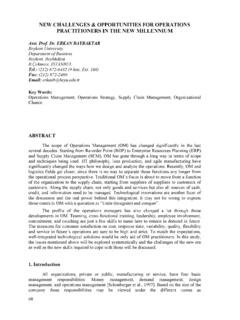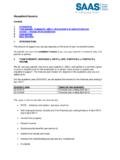Transcription of ANALYSIS OF ENVIRONMENTAL FACTORS THAT AFFECTS …
1 ANALYSIS OF ENVIRONMENTAL FACTORS that AFFECTS . THE SUCCESS AND FAILURE OF THE SMALL AND MEDIUM SIZED. TOURISM ENTERPRISES (SMETE) AND IMPLICATION OF. A RATIONAL STRATEGIC MANAGEMENT MODEL. NEDIM YUZBASIOGLU. Asist Prof. Dr. University of Nigde School of Business Studies, Nigde e-mail: Key Words: Strategic management and implications, service related businesses (Tourism), environment, owner-managers, entrepreneur, small business ABSTRACT. The accommodation and catering which people receive on holiday, for example are some important to them that if these two elements of the holiday are not satisfactory, the entire trip can be ruined. It is, therefore, obvious that the entire reasons for the existence of tourism related business is the satisfactions of the needs of these travellers. Success and failure of the business is, great extend, depend on the fulfilment of this duties. There are some FACTORS that affect success of the business in the service.
2 A strategy implication of the owner- manager is highly depending on data about these FACTORS . The objective of the research is, therefore, to offer a suitable strategy to manager of these businesses. This study classified theses FACTORS as internal and external or controllable and uncontrollable FACTORS . Result of the study made in 1996 and 1999 were compared and discussed. Both study revealed that the internal and external environment of businesses can not be ignored in the assessment of FACTORS relating to barriers to business growth. Managers do not implicate any efficient strategy without identifying these FACTORS . Results of the study indicates that owner-manager must have at least 3 or 4 years of experience to improve their managerial skills which is very prime conditions to survive. Longitudinal studies with support of interviewed data collections method were more advisable to others researchers in the field, since theory and practices are not always match each other.
3 INTRODUCTION. Over the last century, ENVIRONMENTAL concern has periodically reared it's head as a significant issue on social, political and business agenda. Environment is a core feature of the tourism product. Tourist are consumers of the environment, travelling to the producer's location, the tourist's destination, in order to consume the product. Thus tourism is dependent upon the attractive power of a destination's environment, that is the primary resources of climate, scenery, wildlife, cultural and historic heritage. Access to the destination, necessitates an infrastructure for service, one of the most significant FACTORS related to success of the tourism sectors. 34. Wakefield and Blodgen (1996: 45-55) identified three primary dimensions of the services. These are: ! ambient condition ( whether, temperature, air quality, noise, music odours), ! spatial layout and functionality ( the way in which equipment and furnishing are arranged, and ability of those to facilitate consumers enjoyment), and !
4 Signs, symbols and artefacts ( signage and decor used to communicate and enhance a certain image or mood, or to direct consumers to desire destination) (Wakefield and Blodgen 1996). Organisations who provide the accommodation, food and beverage, and entertainment in the tourist's destination can be considered as another important factor (Goodall, 1993:73). When people stay away from home, whether for leisure or business, they need somewhere that provides all the comforts of home. They need accommodation and they need food and drink. No country, or region within a country, can expect to attract large numbers of tourist unless it has an adequate stock of places providing accommodation and catering. Thus, it may be argued that , for the following reasons attention has been given to small firms in the service sector. Firstly, the major shift in the Turkish economy towards the service sector needs to be recognised more clearly in its implication for research into small firms.
5 Second, what is especially important about the increased importance of the service sector in Turkey's economy is that most small firms are in this sector. As a result, it may be argued that the accommodation and catering sector are very important tools for tourism policy because of the contributions of SMETEs in these sectors and the economy of the Turkey as a developing country (Yuzbasioglu, 1997). Since, the recognition of the importance of the small business in the sector necessities accepts the role of managers and personnel who fulfil the needs of tourist as customer in host country. This study is, therefore, concentrate on the perception of owner- managers to ENVIRONMENTAL issues was making an impact on their managerial practices. STRATEGIC MANAGEMENT IN THE BOUNDARY OF THE INTERACTION. BETWEEN TOURISM RELATED BUSINESS AND ENVIRONMENT. The Institute of Business Ethics, Environment and the Company points out that the new climate of heightened political and public awareness of ENVIRONMENTAL issues demands new responses from organisation (Burke and Hill, 1990).
6 This development created new generations of consumer who has demanded new products from retailers, food producers and businesses, which serve these products to them. Tourism due to the size and its global scope and very direct impact on the natural environment, has become a particular focus of new customer who has green and perfect service orientation. The publication of The Green Holiday Guide and rating of countries in terms of suitability of environment have raised consumer awareness about the ENVIRONMENTAL friendliness of their holiday decision. ENVIRONMENTAL problems such as poisonous algae in the Mediterranean and acid rain damage in the black forest, terrorist activities in countries like Turkey have all helped to alert the tourism industry to the cost and dangers of ecosystem damage are caused a instability at tourist destinations. Figure 1 shows that owner-manager must be able to follow ENVIRONMENTAL inter action around their business.
7 There is a balancing managerial strategy necessary to reap the potential economic benefits of business and tourism development as well. On the other hand 35. owner-manager must take into consideration paradoxical structure of sector. According to Mountinho (1990) the tourism industry has a challenge which seems to be a paradox: to package attractions without destroying their attractiveness, to popularise destinations without running their popularity and to develop economic opportunities without limiting human opportunities. The attitude of many consumers to the enjoyment of tourism sector is also paradoxical. On the one hand people want to get away from it all, on the other, they want to find a clean toilets, refreshment and litter bins when they get there. Strategic Management Model Management policy of owner-manager should, therefore, try to make a balance between these paradoxes and interaction between sectors and businesses. And, owner- manager bound to formulate a strategy in line with ENVIRONMENTAL changes.
8 The foundation of 36. strategy formulation is the rational model, which calls for comprehensive ANALYSIS of data (internal and external) prior to decisions being made. Rationality implies that a strategist or decision maker: ! consider all available choices;. ! identifies and evaluates all the consequences which would follow from the adoption of each choice, and ! select the choice that would be preferable in terms of the most valued ends (Meyerson, and Banfield,1995). Rational model necessitate that strategy formulation would involve systematic ENVIRONMENTAL ANALYSIS , assessment of organisational strengths and weaknesses, formulations of goals, evaluation of alternative courses of action, and the development of a comprehensive plan to achieve the goal in the light of data from internal and external organisation. Organisationally this calls for the use of a formal strategic planning system. Firms need to make strategic choices if they are to survive.
9 Some of the strategic choices include: choice of products or services to offer, choice of ways of competing, the choice of organisational structure and policies to define and co-ordinate work within the organisation ibid. Figure 2 Strategic Management Model Analysing the environment: This part of the strategic management process includes the task or market environment, and societal environment. The task environment of a firm includes governments, local competitors, suppliers, employees and other special interest group- associations). These forces directly affect the firm and in turn affected by it. The societal environment influences the long-term operation of the firm the capital goods, all types of 37. infra structure and opportunities. The internal capabilities of the company organisational strengths and weaknesses should be assessed (internal audit). Managers should make an assessment of either of their business or destinations and locations area of the business.
10 Planning direction: This is a toll of strategic management is concerned with the future direction of the organisation. It means that determination of the overall direction for the company: its mission) and, formulating objectives to achieve the mission are part of this exercise. Planning strategy: This part of the process deals with identifying ways of achieving the objectives. Often numbers of alternative strategies are considered. Decision making tolls- for example, simulation, game theory linear programming and statistics are most often used to select the optimal strategy. Implementing strategy: Once the strategy is selected, each of the operations such as marketing, manufacturing, and human resources is aligned in such a way as to be able to contribute to the efficient implementation of the strategy. Information and control system are set up to monitor performance and to take corrective actions when necessary. METHODOLOGY OF THE RESEARCH.






